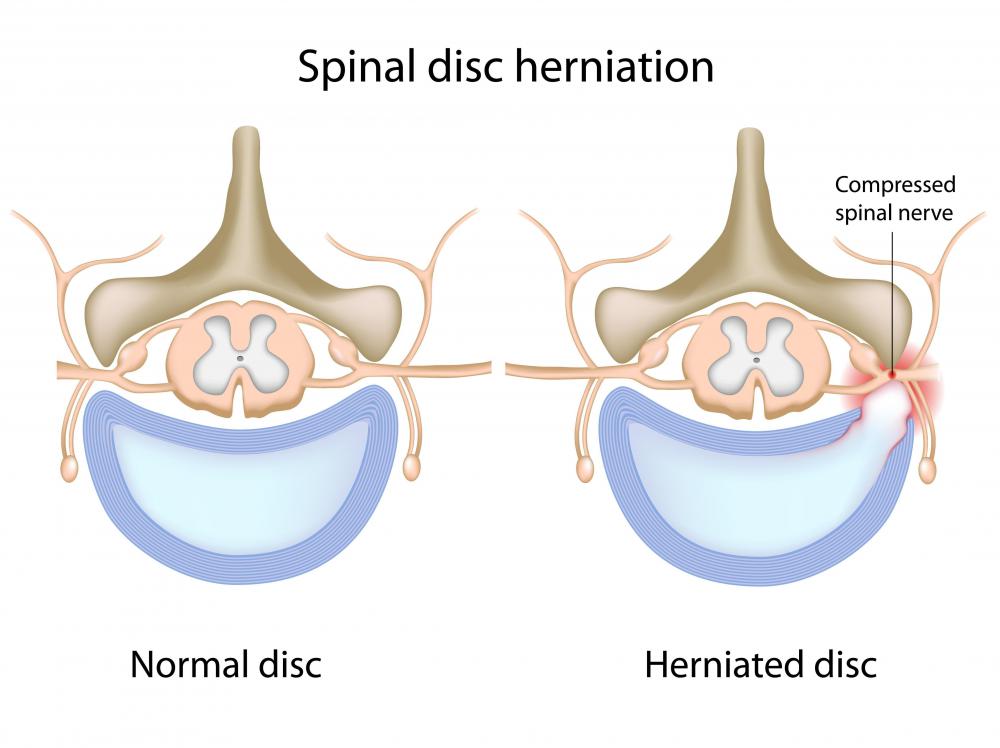At TheHealthBoard, we're committed to delivering accurate, trustworthy information. Our expert-authored content is rigorously fact-checked and sourced from credible authorities. Discover how we uphold the highest standards in providing you with reliable knowledge.
What is Thoracic Disc Herniation?
The thoracic section of the spine is the middle part of the vertebra, which runs along the mid-back between the neck (cervical spine) and the lower back (lumbar spine). A herniated disc can result in any part of the spine and is a result of rupture of one of the cushioning discs between two vertebrae. This causes part of the interior of the disc, called the nucleus pulpous, to extrude. When this disc is located in the thoracic spine, it can be called thoracic disc herniation.
It’s not that common for thoracic disc herniation to occur because the thoracic spine is much more stable than the cervical and lumbar spine regions. The rib cage provides extra stability to this area and the spinal area doesn’t move as much. This doesn’t mean that people can’t get a herniated disc here; it simply means it’s not as likely. Most common causes of disc herniation in this area are degeneration of the spine, usually with aging, or some form of trauma. Trauma could be an injury from a fall, participating in sports, or an activity that moves the back in an unusual way.

The most predictable symptoms of thoracic disc herniation is pain, but some people may have such mild cases, they aren’t aware they have an injury. Pain felt can differ among individuals and depending on which disc is affected. Pain is usually in the upper back, but the chest and abdomen could be affected too. The nerves in this area of the spinal cord are easily compressed, which may lead to pain in other parts of the body, or even to paralysis in some instances.

In order to diagnose this condition, doctors may order x-rays or magnetic resonance imaging (MRI). They could also order computerized tomography scans, if required. Should thoracic disc herniation be present, doctors will determine the degree and make recommendations on how to treat the issue.
If the condition is minor to moderate, the first recommendation might be for patients to get rest for a few days to see if pain improves. Doctors might suggest using non-steroidal anti-inflammatory drugs (NSAIDs) such as ibuprofen to help reduce swelling and deal with discomfort. They can prescribe medications like hydrocodone or codeine too, if NSAIDs alone don’t work. In addition to resting, icing the affected area may reduce swelling and lessen pain. Some people turn to chiropractic care for this condition, and gentle spinal manipulation may be of assistance too.

After the first few days of injury, people are usually guided toward gradually restarting activity. Provided activity is tolerated at an increasingly functional level, surgery for thoracic disc herniation might not be needed. On the other hand, if even the slightest activity makes matters worse, doctors may recommend surgery. It should be noted that a number of people don’t require surgical intervention.
Surgery for thoracic disc herniation can be complex because it is performed on the spine, which contains so many nerves that control the rest of the body. However, these surgeries are performed fairly often. The main goal in treating this injury is to get rid of the extruding material so the disc stops placing pressure on the spine and nerves. After surgery, many make a full recovery, though they may be slightly more at risk for another disc rupture in the same area.
AS FEATURED ON:
AS FEATURED ON:













Discuss this Article
Post your comments